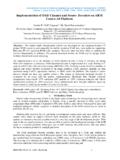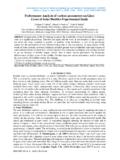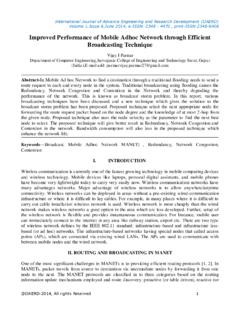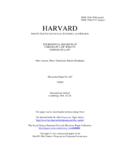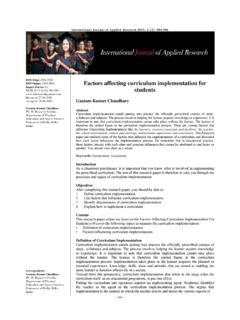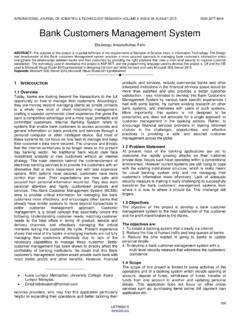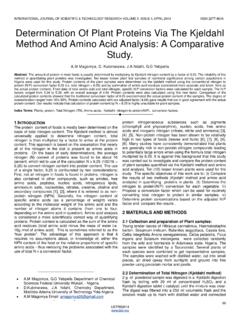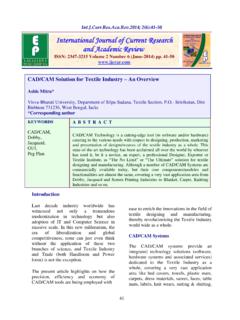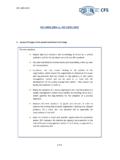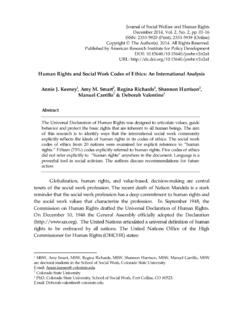Transcription of International Journal of Advance Engineering and Research ...
1 International Journal of Advance Engineer ing and Research Development (IJAERD) Volume 1,Issue 3, Apr il 2014, e- issn : 2348 - 4470 , print - issn :2348-6406 @IJAERD-2014, All rights Reserved 1 Customizable Virtual Mac hine security Analyze r in Cloud Computing Environme nt Patel Deepkumar , Nathwani2 1,2 Computer Engineering , Noble Engineering College Abs tract Cloud Computing is a new model that provides on-demand network access of the computing. Virtua lization technology is for data centers and cloud architectures. It has many security issues that must be point out before cloud computing technology is affected by them. Many companies are starting to utilize the infrastructure-as-a-service (IaaS) sometime called Haas-Hardware as service. Attackers can explore vulnerabilities of a cloud system.
2 In Iaas, detection of zombie exploration attacks is extremely difficult for distributed servers in which various virtua l machine operating. To prevent vulnerable virtual machines from being compromise in the cloud, we depict multiphase distributed liability detection, measurement. Proposed work customizes Framework for virtual machine attack detection and compromise virtua l machine. Ke ywords-Cloud Computing; Iaas ; Virtual Machine; Virtua lization; Security I. INTRODUCTION Cloud computing providers deliver applications via the internet, which are accessed from web browsers and desktop and mobile apps, while the business software and data are stored on servers at a remote location. Clouds are popular because they provide a simple, seamless approach to provis ioning applications and information services.
3 Network-based services, which appear to be provided by real server hardware, and are in fact served up by virtua l hardware, simulated by software running on one or more real machines are often called cloud computing [1]. II. SERVICE PROVIDED BY CLOUD COMPUTING Cloud services may be offered in various forms from the bottom layer to top layer Fig 1: Architecture of Cloud Computing [2] A. Software as a service (SaaS) It is software delivery model in which software and its associated data hosted centrally and accessed by us ing client web browser over internet. B. Platform as a service (PaaS) Offer deployment of application without cost and complexity of buying and managing underlying hardware and software provis ioning hosting capabilities. C. Infras tructure as a se rvice (IaaS) Iaas means computer infrastructure.
4 Virtualization environment. Iaas provides set of APIs application programming interface. It allows management and other forms of interaction with the infrastructure by consumers. International Journal of Advance Engineer ing and Research Development (IJAERD) Volume 1,Issue 3, Apr il 2014, e- issn : 2348 - 4470 , print - issn :2348-6406 @IJAERD-2014, All rights Reserved 2 III. DEPLOYMENT MODELS Three model Public clouds, Private clouds, Hybrid c louds Fig. 2: Cloud computing types [1] A. Private Cloud Private cloud is c loud infrastructure operated solely for a single organization, whether managed interna lly or by a third-party and hosted internally or externally [1]. Example: Eucalyptus ,Ubuntu Enterprise Cloud - UEC (powered by Eucalyptus) ,Amazon VPC (Virtual Private Cloud) ,VMware Cloud Infrastructure Suite ,Microsoft ECI data center B.
5 Public Cloud A cloud is called a "public cloud" when the services are rendered over a network that is open for public use [1]. Example: Google App Engine, Microsoft Windows Azure, IBM Smart Cloud, Amazon EC2 C. Hybrid Cloud Hybrid cloud is a compos ition of two or more clouds (private, community or public) that remain unique entities but are bound together, offering the benefits of multiple deployment models.[1] Examples: Windows Azure (capable of Hybrid Cloud), VMware vCloud (Hybrid Cloud Services) D. Community Cloud Community cloud shares infrastructure between several organizations from a specific community w ith common concerns. [1] Examples: Google Apps for Government, Microsoft Government Community Cloud IV. CLOUD COMPUTING SECURITY THREATS A. Data Bre ach It is a security incident in which unauthorized user do copied, transmitted, sensitive, protected or confidentia l data.
6 Vulnerabilities include Loss of Personally identifiable information (PII), Loss of Encryption keys, and Brute Force attack [3]. B. Account Or Se rvice Traffic Hijacking Attacker gain access to user s data. Vulnerabilities include Session Hijacking, SQL Injections , Cross-site scripting, Man in the middle attack, wrapping attack Problem, Malware injection attack, Soc ial Engineering attack, Phishing attack [3]. C. Data Loss Attacker gain access to Information and delete data. Vulnerabilities inc lude Loss of Encryption keys, Cloud service termination, and Hardware or Software failure, Natural Disaster, Human Error [3]. D. Denial of Se rvice [3][4] Denial-of-service attacks are attacks meant to prevent users of a cloud service from being able to access their data or their applications.
7 By forcing the victim cloud service to consume in ordinate amounts of finite system resources such as process or power, memory, disk space or network bandwidth, the attacker causes an intolerable system slowdown and leaves all of the legitimate service users confused and angry as to why the service isn t responding[3]. 1) Vulne rabilities : A. Zombie attack [7] Through Internet, an attacker tries to flood the victim by sending requests from innocent hosts in the network. These types of hosts are called zombies. In the Cloud, the requests for Virtual Machines (VMs) are International Journal of Advance Engineer ing and Research Development (IJAERD) Volume 1,Issue 3, Apr il 2014, e- issn : 2348 - 4470 , print - issn :2348-6406 @IJAERD-2014, All rights Reserved 3 accessible by each user through the Internet.
8 An attacker can flood the large number of requests via zombies. Such an attack interrupts the expected behavior of Cloud affecting availability of Cloud services [3]. attack It is combination of HTTP and XML messages that are intentiona lly sent to flood and destroy the communication channe l of the cloud service provider. C. De tection of DDOS [3] DIDS (Distributed Intrusion Detection System) Signature based, open source network analyzer, snort is proposed to generate logs. Hidde n Markova Mode l [3] SQL server 2005 is used to collect all the deta ils of all the clients and check the browsing behavior of the users by hidden Markova Model. If Anomaly is detected then it denies the access of the users. Entropy [3] Entropy is a measure of randomness. Each incoming request sessions entropy is calculated and is compared to predefined value in a system if greater deviation is found then user request of that session is declared as anomalous.
9 Se mantic rule based approach [3] It is used to detect anomaly in c loud application layer. A deterministic finite automaton is used to represent different malic ious characteristics. De mps te r Shafe r Theory [3] It is applied to detect DDOS threat in cloud environment. It is an approach for combining evidence in attack conditions. E. Insecure Inte rfaces and API s [3] It provide set of API to interact with cloud service Vulnerabilities inc lude Malic ious or unidentified access, API dependencies, limited monitoring/logging capabilities, inflexible access controls, anonymous access, reusable tokens/passwords and improper authorizations[3]. F. Malicious ins ide rs [3] A malic ious insider threat that misuse access Vulnerabilities include Rogue Administrator, Exploit Weaknesses Introduced by Use of the Cloud, Us ing the Cloud to Conduct Nefarious Activity, Lack of transparency in management process[3].
10 G. Abuse of cloud se rvices It inc ludes Use of cloud computing for crimina l activities, Illegal activity by c loud service provider [3]. H. Ins ufficie nt Due Dilige nce Without understanding cloud service provider environment user push application in cloud environment. Vulnerabilities include insufficient skills and know ledge [3]. I. Share d Technology vulne rabilities Infra structure as service (Iaas) vendor delivers their services to users. Vulnerabilities inc lude VM Hopping, VM Escape, VM Escape, Cross-VM side-channel attack [3]. V. RELATED WORK Pape r Title & Approach 1) An Analys is of Intrus ion Detection Sys tem in Cloud Environme nt Ambikavathi C , [5] defines Cloud computing being a distributed mode l, need of secure usage is a major issue. The goal of cloud IDS is to analyze events happening on the cloud network and identify attacks.


